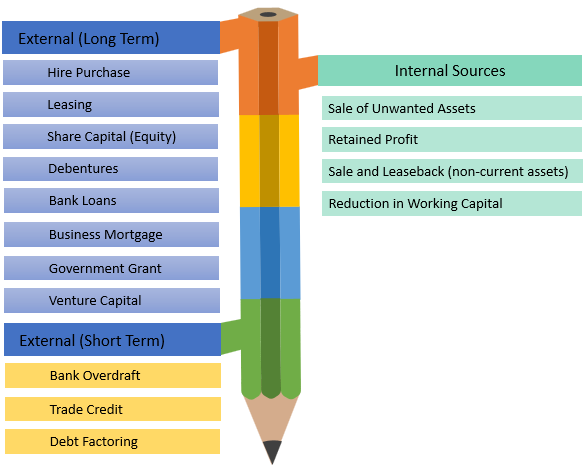AS Business Studies 9609
Business Studies – 5.2 Sources of Finance
- The relationship between business ownership and sources of finance
- Internal and External Sources of Fiance
- Factors affecting the sources of finance
- Selecting an appropriate source of finance in context
Internal sources of finance
Money kept in the business by the owners. Known as retained profit on the balance sheet.
- No need to pay interest on the money
- Instantly available (allows the business to grow)
- Could have been invested elsewhere, earning a higher profit
- The business may not have enough retained profit to meet its needs
- Shareholders may become unhappy if this means lower dividend payments.
Internal sources of finance are when a business raises finance from within. Internal sources are the assets (current and non-current) or profit left in the business (retained profit).
External sources of finance are money raised from outside the business such as bank loans or investments from shareholders.

Short-term sources of finance are money needed for a short period, usually within one year. Long-term sources of finance are used when money is required for more than one year.
Items owned by the business are sold and the money made is used to finance the business.
- The business is using money it already has – so no need to take on loans or pay any interest or charges.
- Increases the liquidity of the business as money is not tied up in non-current assets (machines no longer needed).
- The business must have something worth selling
- The business may sell something they later need
External sources of finance
An amount of money borrowed from the bank, then repaid (with interest) over a set period.
- Easy and quick to set up
- Large amounts of money can be borrowed
- Structured repayment terms over a period of time
- Interest will need to be paid on the loan (interest rates can go up)
- If repayments cannot be kept up, the business risks getting a poor credit rating or being made bankrupt
Exam Tip
For paper two case study questions, provide context by analysing the appropriate source of finance for the business. For example, a Sole Trader will not have the same options to raise finance as a Public Limited company.
Remember finance provided by shareholders when buying shares is a form of external finance. This is because companies have a separate legal identity and therefore shareholders provide external finance and are not liable for the debts of the business.
Items bought from suppliers on a ‘buy now pay later’ basis. Often businesses can arrange agreements to pay for (stock) after 30 or 60 days.
- It gives the business more cash to use in the immediate future
- Delaying payments can free up additional money in the business.
- Can only be used to buy certain goods
- Bills usually have to be settled within 30,60 or 90 days
Long-term borrowing is similar to selling shares but with the promise of repaying the amount lent over a fixed period of time, usually for a set amount of interest.
- Structured method which allows the business to know exactly how much interest will be paid and when the debt has to be paid back.
- Usually ‘secured’ against assets of the business such as property, if the interest on the debt, or the debt itself isn’t repaid, the debenture holder will claim the item/property.
- No longer a popular method of finance for businesses
Key Terms
Microfinance provides small sums of capital to entrepreneurs who may not be able to get bank loans. Microfinance is usually popular in low-income or developing countries.
Crowdfunding is usually done online where a large number of people provide small amounts of money to fund a new business venture.
Long-term loan provided by a bank to buy property.
- The only method available to buy property
- Structured repayments over a long term (25 years)
- Becomes a non-current liability
- Large sums of interest charged
- Can take a long time to repay debt (non-current liabilities increase)
An item is bought on finance, repayments are made each month until the final payment when the item becomes the property of the business.
- Flexible method – can hand back the item if no longer required and payments will stop.
- High interest is often charged
- Item doesn’t belong to the business until the end of the term
Money is given to the business by the government. Grants can be used to help finance new projects – especially those that create new
jobs in underdeveloped areas within a country.
- No need to pay interest
- No need to repay the grant
- Limited funds are available
- There may be restrictions on what the money can be used for.
Money is put into the business by the owner, usually from personal savings.
- No need to pay interest
- Could have been invested elsewhere, earning a higher profit
- Owner may not have enough funds to meet the needs of the business
The company sells a debt it is owed to a debt factoring company which pays the business a smaller sum than they were owed.
- Allows the business to get money for debts that might otherwise never have been paid
- Saves the business time chasing customers etc for money owed
- Time time-consuming to arrange
- The business receives less money than it was originally owed – this may affect profitability.
Start-up capital is the money needed by an entrepreneur to set up a business. Working capital is the money needed to pay for the day-to-day running costs of a business. Working capital also includes credit offered to customers and money needed to pay for raw materials.
Used to help obtain new equipment eg cars. The business rents the item from its owner. Another option is to sell the item or equipment and then lease it back. This is known as a sale and leaseback.
- The cost of the asset is spread over its life
- No need to find a lump sum of money to purchase it
- May be more expensive than buying the asset – the owner will want to profit from the deal
- The business does not own the asset so it does not appear on the balance sheet
The bank allows the business to draw more money from their bank account than they actually have available.
- Quick to arrange
- A good short-term solution to a cash flow problem
- Only suitable for smaller amounts and has to be repaid within a short amount of time
- Interest or charges are paid
A share in the business is sold to an individual or another business. This money is known as share capital and can then be used to purchase new assets or expand the business.
- No need to repay the money invested by shareholders
- Cheaper than a loan as there is no interest to be paid
- Some businesses can raise large sums of money this way
- Need to pay the shareholders a share of future profits
- Ownership also means some influence over how the business is run – the original owners may lose control of the business
- Risky for the shareholder – the investment may be lost if the business fails
Venture capitalists invest in small, risky businesses e.g. new business start-ups. A good example of businesses raising venture capital is ‘Dragon’s Den’.
- Can raise money even when banks have refused to lend to the business
- Risky for the venture capitalist
- The VC may want to have some control over how the business operates
Section A 5.2 Sources of Finance Practice for Paper One
Section B 5.2 Sources of Finance Practice for Paper One
Revision videos for Sources of Finance:
Revision Videos

Choosing Appropriate Sources
Coming soon…

Internal and External Sources
Coming soon…

Practice for Business Finance
Coming soon…

Exam Practice
Practice business studies exam-style questions.

Expert Teacher
Experienced in teaching business studies GCSE and A-Level.

Access business topics
Access an overview of all business studies topics, including top exam tips.
Get Additional Business Studies Resources!
Access additional business studies resources including sample questions and detailed examination feedback.
